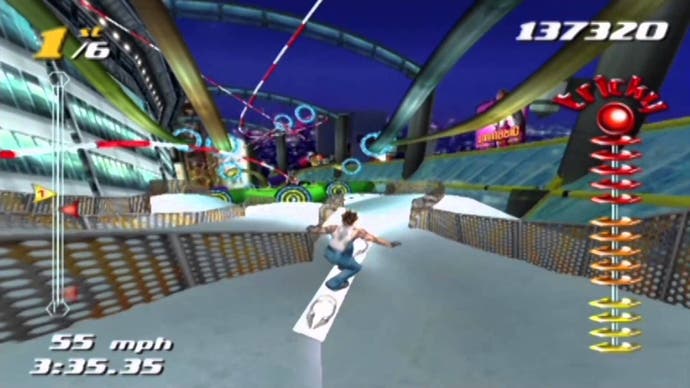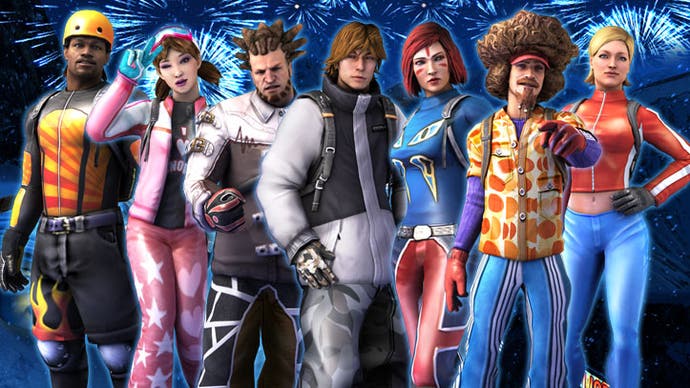Few games obsessed me like SSX Tricky
Cool.
If the game industry gives me just one last remaster before its remastering machines run dry, please let it be SSX Tricky. From today’s point of view, when many big publishers are still betting on realistic stylings and serious performances, it’s probably not as simple to make a case for SSX Tricky as it was to make one for a series like Tony Hawk’s. Both may have a killer soundtrack and are certainly beloved sports games for players of my generation, but SSX Tricky could never act as a vehicle for its sport or the sporting personalities behind it. It fundamentally lacks the real-life marketing and real-life history that is such a big part in FIFA, F1 and the other sports games with annual releases and big licensing deals.
However, its ultra-arcade stylings, completely untethered from how real snowboarding events actually work (I wouldn’t know, but I doubt its ice tunnels and sky-high rails are a thing), turned out to be its big selling point. Everything about SSX Tricky is loud and disobedient, but unlike Jet Set Radio, it still comes packaged as a sporting competition, just one where knocking opponents off the track is openly encouraged and rewarded.
I have only played a few games in my life with the sort of obsession I had with SSX Tricky. I wanted to perfect every course, and unlock every outfit for every character, and I think I did because SSX Tricky is the kind of game that makes you feel cool in a number of ways which are all equally important. There’s the low skill ceiling - you get to feel cool with very little, and you can invest in your skill and become really good at the game, a feeling I didn’t really get to experience in other sports games until then. Landing a cool trick in SSX Tricky is easy, in part because of the good controls, but also because even the simplest trick looks cool. Your character and the announcer react, the number of points, no matter how high, looks nice and big, and then there’s of course the shout of “Tricky!” that celebrates your successful landing. It’s even better when you get a lot of airtime, which the game sets up on each track with giant, unmissable ramps at least once. For a moment, you hear nothing but the howling of the wind, and it’s just you and the sky.
There’s always something about throwing yourself from a big height in video games, but it’s even better when you can use it to pull a ridiculous trick, like the Propeller, during which riders are making their boards spin like propellers in front of their faces, or the LaLaLa Lock Step, where riders spin their board clockwise and spin themselves counter-clockwise. These tricks are obviously too wild to be real, but I feel like they were designed in a way that still makes you feel like they could be real. They have their origins in feats of athleticism or dance moves, and they look so slick that I still enjoy a lot of them for the animation, even as the rest of the game has unfortunately not aged as gracefully.
SSX Tricky understood something about characters that licensed games can take for granted – sports games are often more fun if you can enjoy them as someone you like. In FIFA, you play as your favourite team, and watching Tony Hawk’s digital alter ego age in Tony Hawk 1+2 was a glorious moment both for those of us who had grown up with the real skater as well as those for whom he was just a digital avatar. But the snowboarding scene, and Tricky as an arcade game, as previously mentioned, had no such recognisable faces, so it just made its own.
SSX Tricky’s characters aren’t just avatars with very distinct fashion tastes; they have backstories, friendships, rivalries and favourite movies. I will say that some of the character designs skate a little close to caricatures – as nice as it is to have a Latino character in Marisol Diez Delgado from Venezuela, she is described as a “mix of innocence and raw sexuality, someone who can’t keep her temper under control and likes to party all night”. Typical Latina stereotype. Similarly, the African-American Seeiah Owens is "a self-sufficient sistah'' who's into R&B and Spike Lee films. Back in the early 2000s, it was simply neat to see such characters exist, nowadays I would have a word with their designers. As executive producer Steve Rechtschaffner put it at the time, “subtlety probably wasn’t going to be a good thing with characters.”
Even those characters, as stereotypical as they are, are brought to vibrant life by their voice actors. SSX Tricky, a snowboarding game, was voiced by a group of people that could rival an early 2000s Pixar movie cast. Ok, maybe Dreamworks, but you get the point. The game has a great DVD extras section, generally a lovely idea to collect bonus material, where every voice actor gets introduced and they dutifully say PR snippets like “I didn’t know video games could look like that,” and, “yes, I play it a lot,” while looking like a person with a camera assaulted them at 5am with a foot out the door. Celebrities like Macy Gray, Oliver Platt and David Arquette and the legend that is then-EA senior marketing manager Nick Malapariman were suddenly voicing video game characters (or in Malapariman’s case, giving his best impression of a Chelsea fan on the stands), and while in reality they’re just shouting a bunch of barks at top volume, I was so fascinated by what they were selling that I became a massive fan of game voice acting then and there - and I am to this very day.

Like the name implies, SSX Tricky is SSX, a snowboard racing game, with more tricks, because its makers realised that the trick part was what would be most interesting to people. Maybe that isn’t so much the case for other sports, although I’d love for someone to have another go at a Captain Tsubasa-style trick-shot football game. But it seemed clear that SSX Tricky’s big selling point was just what it said on the box, which is why I still don’t grasp the incentive of walking the series back to something relatively bland with successive instalments. It feels like EA went back to something that was easier to explain and to market to a large group of people, which was ironically what no one wanted.
SSX Tricky was the product of many great artists coming together, people who knew their subjects really well, be that acting, animation or music, which was produced by The Beastie Boys’ Mixmaster Mike. It’s a wealth of talent we now almost take for granted in the gaming industry, what with its size and monetary worth, and SSX Tricky to me is an example of how all those resources could be used.
Perhaps, instead of a remake of a very 2000s-style game, we should have a new SSX Tricky – made by a diverse group of people with the resources EA has now, it could be a great reminder of the spirit of the original game and EA Sports BIG, the label that so wanted to offer a different experience. At a time when EA isn’t known for being particularly adventurous, it would be great to see something a little wild.


